| |
|
Xiamen Oil Paintings, Wholesale Direct!
|
|
100% hand painted, 100% cotton canvas, 100% money back if not satisfaction. |
|
|
|
|
ART WORKS INDEX
A
B
C
D
E
F
G
H
I
J
K
L
M
N
O
P
Q
R
S
T
U
V
W
X
Y
Z
|
|
ARTISTS INDEX
A
B
C
D
E
F
G
H
I
J
K
L
M
N
O
P
Q
R
S
T
U
V
W
X
Y
Z
|
|
|
|
|
|
 |
DUCK, Jacob
|
|
Dutch painter (b. ca. 1600, Utrecht, d. after 1660, Utrecht)
|
|
|
|
|
|
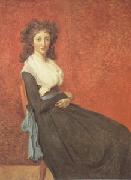 |
David, Jacques-Louis
|
|
French Neoclassical Painter, 1748-1825
Jacques-Louis David is famous for his huge, dramatic canvasses of Napoleon and other historical figures, including Oath of the Horatii (1784), Death of Marat (1793) and The Sabine Women (1799). Early in his career he was a leader in the neoclassical movement; later his subjects became more modern and political. David was himself active in the French Revolution as a supporter of Robespierre and is sometimes called the chief propagandist for the Revolution; after the Reign of Terror ended he was briefly imprisoned for his actions. When Napoleon took power David became his court painter and created several grand canvasses of the Emperor, including the heroic Napoleon Bonaparte Crossing the Alps (1801) and the enormous Coronation of Napoleon and Josephine (1807). David also painted Napoleon in His Study (1812),
|
|
 |
David Johnson
|
|
American Landscape painter.
b.1827 d.1908
was a member of the second generation of Hudson River School painters. He was born in New York City, New York. He studied for two years at the antique school of the National Academy of Design. He also studied briefly with the Hudson River artist Jasper Francis Cropsey. Along with John Frederick Kensett and John William Casilear, he was best known for the development of Luminism. By 1850, Johnson was exhibiting regularly at the National Academy of Design in New York, where he became an associate in 1860.
|
|
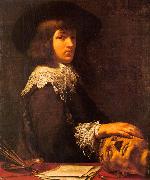 |
Daret, Jean
|
|
Flemish Baroque Era Painter, 1613-1668
French painter. He came from Brussels and trained there before going on the traditional journey to Italy, which not only took him to Rome but also brought him into contact with contemporary masters at Bologna. While in Italy he produced a Self-portrait (1636; St Petersburg, Hermitage), which alludes to both his ideal model and the necessary basis of his work: his right hand rests on a fragment of antique sculpture, while beside his palette in the foreground lie several sheets of drawings.
|
|
 |
DARET, Jacques
|
|
Netherlandish Northern Renaissance Painter, ca.1404-1470
was an Early Netherlandish painter born in Tournai (now in Belgium), where he would spend much of his life. Daret spent 15 years as a pupil in the studio of Robert Campin, alongside Rogier or Rogelet de le Pasture (assumed by scholars to be Rogier van der Weyden, both words meaning "field" or "meadow" in French and Dutch respectively), and afterwards became a master in his own right. He became a favorite of the Burgundian court, and his patron for 20 years was the abbot of St. Vaast in Arras, Jean de Clercq. Though many works of Daret are mentioned in Jean de Clercq's account books, only four panels of Daret's works are known to have survived: all are from the so-called Arras Altarpiece or Saint-Vaast Altarpiece, painted for the abbot between 1433 and 1435. These paintings show a striking resemblance to the Flemish realism of the Master of Flemalle. This is argued by most scholars to be evidence that the Master of Flemalle was Daret's master, Robert Campin. Daret features rather more in the art historical debates over his period than the merit of his work alone would justify because he is relatively well-documented, and in particular can be securely identified as the creator of the altarpiece mentioned above, as well as a pupil of Campin. The stylistic similarity between him and the Master of Flemalle is therefore crucial evidence in the identification of the latter with Campin. This then becomes an important connection in establishing a link between Robert Campin/the Master of Flemalle and his other major pupil,
|
|
|
|
 |
COURTOIS, Jacques
|
|
French Baroque Era Painter, 1621-1676
was a French painter. He was born at Saint-Hippolyte, near Besançon. His father was a painter, and with him Jacques remained studying up to the age of fifteen. Towards 1637 he went to Italy, was received at Milan by a Burgundian gentleman, and entered, and for three years remained in the French military service. The sight of some battle-pictures revived his taste for fine art. He went to Bologna, and studied under the friendly tutelage of Guido Reni; thence he proceeded to Rome, where he painted, in the Cistercian monastery, the "Miracle of the Loaves." Here he took a house and after a while entered upon his own characteristic style of art, that of battle-painting, in which he has been accounted to excel all other old masters; his merits were cordially recognized by the celebrated Cerquozzi, named Michelangelo delle Battaglie. He soon rose from penury to ease, and married a painter's daughter, Maria Vagini; she died after seven years of wedded life. Prince Matthias of Tuscany employed Courtois on some striking works in his villa, Lappeggio, representing with much historical accuracy the princes military exploits. In Venice also the artist executed for the senator Sagredo some remarkable battle-pieces. In Florence he entered the Society of Jesus, taking the habit in Rome in 1655; it was calumniously rumoured that he adopted this course in order to escape punishment for having poisoned his wife. As a Jesuit Brother, Courtois painted many works in churches and monasteries of the society. He lived piously in Rome, and died there of apoplexy on 20 May 1676 (some accounts say 1670 or 1671). His battle-pieces have movement and fire, warm colouring (now too often blackened), and great command of the brush, those of moderate dimensions are the more esteemed. They are slight in execution, and tell out best from a distance.
|
|
|
|
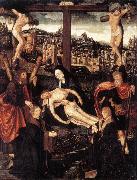 |
CORNELISZ VAN OOSTSANEN, Jacob
|
|
Dutch Northern Renaissance Painter, ca.1472-1533
North Netherlandish painter, designer and woodcutter. He was the brother of Cornelis Buys I ( fl 1490-1524), who is usually identified as the MASTER OF ALKMAAR (see MASTERS, ANONYMOUS, AND MONOGRAMMISTS,
|
|
|
|
 |
Cornelis Janssens van Ceulen
|
|
(also Cornelius Jonson van Ceulen, Cornelius Johnson, Cornelis Jansz. van Ceulen and many other variants)(bapt. October 14, 1593, London - bur. August 5, 1661, Utrecht) was an English painter of portraits of Dutch or Flemish parentage. He has been described as "one of the most gifted and prolific portrait painters practising in England during the 1620s and 1630s".
Janssens van Ceulen was born to Dutch or Flemish parents in London - his father had been a refugee from Antwerp, and the family had originated in Cologne. He was baptised at the Dutch church at Austin Friars, the son of Johanna le Grand and Cornelius Johnson. He may have been trained in the Netherlands, and was certainly influenced by other artists from the Netherlands, but he was active in England, at least from 1618 to 1643. In the 1620s, he lived and had his studio in Blackfriars, London, as did Anthony van Dyck; it was just outside the boundaries of the City of London, and so avoided the monopoly in the City of members of the London painters' Guild. He married Elizabeth Beke of Colchester in 1622. Janssens' son (Cornelius Janssens, junior) was born in 1634. He was also a painter. Janssens' daughter was married to Nicholas Russell of Bruges. Janssens moved to Canterbury in the mid 1630s, living with Sir Arnold Braems, a Flemish merchant. Janssens continued to live in England until after the outbreak of the English Civil War, but in October 1643, apparently at the insistence of his wife, he moved to Middelburg, and between 1646 and 1652 he lived in Amsterdam, before settling in Utrecht, where he was buried.
|
|
 |
COPLEY, John Singleton
|
|
American Colonial Era Painter, 1738-1815
American portrait painter, b. Boston. Copley is considered the greatest of the American old masters. He studied with his stepfather, Peter Pelham, and undoubtedly frequented the studios of Smibert and Feke. At 20 he was already a successful portrait painter with a mature style remarkable for its brilliance, clarity, and forthright characterization. In 1766 his Boy with the Squirrel was exhibited in London and won the admiration of Benjamin West, who urged him to come to England. However, he remained in America for eight years longer and worked in New York City and Philadelphia as well as in Boston. In 1774 Copley visited Italy and then settled in London, where he spent the remainder of his life, enjoying many honors and the patronage of a distinguished clientele. In England his style gained in subtlety and polish but lost most of the vigor and individuality of his early work. He continued to paint portraits but enlarged his repertoire to include the enormous historical paintings that constituted the chief basis of his fame abroad. His large historical painting The Death of Lord Chatham (Tate Gall., London) gained him admittance to the Royal Academy. His rendering of a contemporary disaster, Brook Watson and the Shark (Mus. of Fine Arts, Boston), stands as a unique forerunner of romantic horror painting. Today Copley's reputation rests largely upon his early American portraits, which are treasured not only for their splendid pictorial qualities but also as the most powerful graphic record of their time and place. Portraits such as those of Nicholas Boylston and Mrs. Thomas Boylston (Harvard), Daniel Hubbard (Art Inst., Chicago), Governor Mifflin and Mrs. Mifflin (Historical Society of Pennsylvania, Philadelphia), and Paul Revere (Mus. of Fine Arts, Boston) are priceless documents in which the life of a whole society seems mirrored.
|
|
|
|
|
|
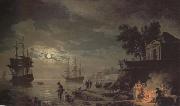 |
Claude-joseph Vernet
|
|
French Painter, 1714-1789
Vernet probably received his first lessons in painting from his father, Antoine, who then encouraged him to move to the studio of Philippe Sauvan (1697-1792), the leading master in Avignon. Sauvan supplied altarpieces to local churches and decorative works and mythologies for grand houses in the area. After this apprenticeship Vernet worked in Aix-en-Provence with the decorative painter Jacques Viali ( fl 1681- 1745), who also painted landscapes and marine pictures. In 1731 Vernet independently produced a suite of decorative overdoors for the h?tel of the Marquise de Simiane at Aix-en-Provence; at least two of these survive (in situ) and are Vernet's earliest datable landscapes. These are early indications of his favoured type of subject, and Vernet would have studied works attributed to such 17th-century masters as Claude Lorrain, Gaspard Dughet and Salvator Rosa in private collections at Aix and Avignon. Three years later Joseph de Seytres, Marquis de Caumont, who had previously recommended Vernet to the Marquise de Simiane, offered to sponsor a trip to Italy.
|
|
 |
Claude Joseph Vernet
|
|
Claude-Joseph Vernet (14 August 1714 - 3 December 1789) was a French painter. His son, Antoine Charles Horace Vernet, was also a painter.
Vernet was born in Avignon. When only fourteen years of age he aided his father, Antoine Vernet (1689-1753),[1] a skilled decorative painter, in the most important parts of his work. The panels of sedan chairs, however, could not satisfy his ambition, and Vernet started for Rome. The sight of the sea at Marseilles and his voyage thence to Civitavecchia (Papal States' main port on the Tyrrhenian Sea) made a deep impression on him, and immediately after his arrival he entered the studio of a marine painter, Bernardino Fergioni.
Slowly Vernet attracted notice in the artistic milieu of Rome. With a certain conventionality in design, proper to his day, he allied the results of constant and honest observation of natural effects of atmosphere, which he rendered with unusual pictorial art. Perhaps no painter of landscapes or sea-pieces has ever made the human figure so completely a part of the scene depicted or so important a factor in his design. In this respect he was heavily influenced by Giovanni Paolo Panini, whom he probably met and worked with in Rome. Vernet's work draws on natural themes, but in a way that is neither sentimental or emotive. The overall effect of his style is wholly decorative.[2] "Others may know better", he said, with just pride, "how to paint the sky, the earth, the ocean; no one knows better than I how to paint a picture". His style remained relatively static throughout his life. His works' attentiveness to atmospheric effects is combined with a sense of harmony that is reminiscent of Claude Lorrain.
|
|
|
|
|
|
|
|
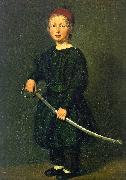 |
Christian Albrecht Jensen
|
|
1792-1870
Danish
Christian Albrecht Jensen Galleries
1792-1870
Danish
Christian Albrecht Jensen Galleries
was a Danish painter, born in Bredstedt, Nordfriesland. In 1818, he traveled to Rome, and met the sculptor Bertel Thorvaldsen. His work is representative of the Golden Age of Danish Painting.
|
|
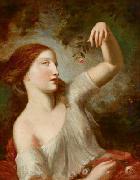 |
Charles-Joseph Natoire
|
|
(3 March 1700 - 23 August 1777) was a French painter in the Rococo manner, a pupil of François Lemoyne and director of the French Academy in Rome, 1751-1775. Considered during his lifetime the equal of François Boucher, he played a prominent role in the artistic life of France.
He is remembered above all for the series of the History of Psyche for Germain Boffrand's oval salon de la Princesse in the Hôtel de Soubise, Paris, and for the tapestry cartoons for the series of the History of Don Quixote, woven at the Beauvais tapestry manufacture, most of which are at the Château de Compiegne.
|
|
 |
Charles Joshua Chaplin
|
|
(8 June 1825 - 30 January 1891) was a French painter and engraver. He was born in Les Andelys, Eure, France to an English father and a French mother. Although he spent the whole of his life in France, he only became naturalized in 1886. He died in Paris, France.
Chaplin conducted art classes specifically for women at his studio. The American artist Mary Cassatt and the English artist Louise Jopling were among Chaplin's students.
|
|
 |
Charles Jervas
|
|
Charles Jervas (c. 1675 - 1739) was an Irish portrait painter, translator, and art collector of the early 18th century.
Born in County Offaly,Ireland around 1675, the son of John Jervas and Elizabeth, daughter of Captain John Baldwin of Shinrone Castle & Corolanty, High Sheriff of County Offaly. Jervas studied in London, England as an assistant under Sir Godfrey Kneller between 1694 and 1695.
After selling a series of small copies of the Raphael Cartoons circa 1698 to Dr. George Clarke of All Souls College, Oxford, the following year he travelled to Paris and Rome (while financially supported by Clarke and others) remaining there for most of the decade before returning to London in 1709 where he found success as a portrait painter.
|
|
 |
Charles Jacque
|
|
(23 May 1813 - 7 May 1894) was a French painter of animals (animalier) and engraver who was, with Jean-François Millet, part of the Barbizon School. He first learned to engrave maps when he spent seven years in the French Army.
Fleeing the Cholera epidemics that besieged Paris in the mid-nineteenth century, Charles Jacque relocated to Barbizon in 1849 with Millet. There, he painted rustic or pastoral subject matter: shepherds, flocks of sheep, pigs, and scenes of farm life. In addition to painting, Jacque was also famous for his etchings and engravings. He, along with Felix Bracquemond and Felix Buhot, is credited with the nineteenth-century revival of seventeenth-century techniques. He began his career as an engraver around 1841 by publishing a series of etchings with Louis Marvy. He followed this work with a serious of engravings based on the works of Adriaen van Ostade, after which he began to create original engravings / artworks. Charles Baudelaire said of him, "Mr. Jacque new reputation will continue to grow always, we hope. His etchings are very bold and his subject matter is well conceived. All that Mr. Jacque does on copper is filled with a freedom and a frankness which reminds one of the Old Masters.
|
|
|
|
 |
Cazin Jean-Charles
|
|
French landscapes painter and ceramist , 1841-Le Lavandou 1901
Painter and ceramicist. His earliest paintings reveal close affinities with the realist tradition, while his later compositions (mostly landscapes of northern France) demonstrate an awareness of Impressionism and a commitment to recording the changing effects of light and atmosphere. He was sent to England for health reasons but by 1862 or 1863 was living in Paris and active in avant-garde artistic circles.
|
|
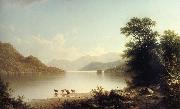 |
Casilear John William
|
|
American Hudson River School Painter, 1811-1893
was an American landscape artist belonging to the Hudson River School. Casilear was born in New York City. His first professional training was under prominent New York engraver Peter Maverick in the 1820s, then with Asher Durand, himself an engraver at the time. Casilear and Durand became friends, and both worked as engravers in New York through the 1830s. By the middle 1830s Durand had become interested in landscape painting through his friendship with Thomas Cole. Durand, in turn, drew Casilear's attention to painting. By 1840 Casilear's interest in art was sufficiently strong to accompany Durand, John Frederick Kensett, and artist Thomas P. Rossiter on a European trip during which they sketched scenes, visited art museums, and fostered their interest in painting. Casilear gradually developed his talent in landscape art, painting in the style that was later to become known as the Hudson River School. By the middle 1850s he had entirely ceased his engraving career in favor of painting full-time. He was elected a full member of the National Academy of Design in 1851, having been an associate member since 1831
|
|
|
|
 |
Carl Joseph Begas
|
|
Carl Joseph Begas (September 30, 1794 - November 24, 1854), was a German historical painter born at Heinsberg near Aachen. His father, a retired judge, destined him for the legal profession, but the boy's tastes pointed definitely in another direction. Even at school he was remarked for his wonderful skill in drawing and painting, and in 1812 he was permitted to visit Paris in order to perfect himself in his art.
He studied for eighteen months in the atelier of Antoine Jean Gros then began to work independently. In 1814 his copy of The Madonna della Sedia was bought by the king of Prussia, who was attracted by the young artist and did much to advance him. He was engaged to paint several large Biblical pictures, and in 1825, after his return from Italy, continued to produce paintings which were placed in the churches of Berlin and Potsdam. Some of these were historical pieces, but the majority were representations of Scriptural incidents. Begas was also celebrated as a portrait-painter, and supplied to the royal gallery a long series of portraits of eminent Prussian men of letters. At his death he held the post of court painter at Berlin.
|
|
|
|
|
|
|
|
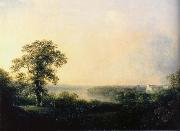 |
Carl Johan Fahlcrantz
|
|
Swedish, 1774-1861, Swedish painter. He began his artistic training in Stockholm as a pupil of the theatre painters J. G. Brusell and E. Limnell (1764-1861). He also studied under the French landscape painter Louis Belanger (1736-1816). In 1805 he was awarded a scholarship to go to Italy, but he preferred to use it to travel within Sweden, as this corresponded more with his interest in painting his native landscape in a National Romantic style. Fahlcrantz settled permanently in Sweden, never travelling outside the Nordic countries. In 1819 he became a professor at the Royal Academy of Arts in Stockholm and in the 1820s Karl XIV commissioned a series of major works from him. Oscar I followed suit, as did numerous other buyers inside and outside Sweden. In this way, Fahlcrantz's paintings were distributed as far as Denmark, Bavaria, Russia and America.
|
|
 |
Carel Jacobus Behr
|
|
(9 July 1812 in The Hague - 11 November 1895) was a Dutch painter, watercolorist and draftsman. He was a pupil of Bartholomeus Johannes van Hove and mainly painted cityscapes, genre scenes and portraits.
In 1836 he produced, commissioned by The Hague municipal government, an image of the town hall there, which carried off the approval of connoisseurs. In 1837 he became a member of the Royal Academy in Amsterdam. His work is found in various collections and different exhibitions, like at the Hague in 1839, Rotterdam in 1840 and again at the Hague in 1841.
|
|
|
|
 |
CAMPEN, Jacob van
|
|
Dutch Baroque Era Painter, 1595-1657
Chief exponent of Classicism in The Netherlands. He studied architecture in Italy and was influenced by the work of Scamozzi and Palladio. With his Coymans House on the Keizersgracht, Amsterdam (1624), he introduced the Palladian style to The Netherlands. His most refined work is the Mauritshuis in The Hague (1633?C5), which has a Palladian plan, elevations featuring a Giant Order of Ionic pilasters set on a plain base, a pedimented central section given little emphasis, and a hipped roof. Much grander is the Town Hall (now Royal Palace), Amsterdam (1648?C55): it has two internal courtyards separated by a huge central hall, façades with two superimposed Giant Orders of pilasters, and a large projecting pedimented central section over which is a domed lantern. His Nieuwe Kerk (New Church), Haarlem (1645?C9), is based on the quincunx plan (essentially a Greek cross within a square), with square Ionic crossing-piers and a groin-vault over the crossing. He was responsible for the Accijnshuis, Amsterdam (1638), the Noordeinde Palace, The Hague (1640), and, with others, the decorations of Post's Huis-den-Bosch, Maarssen, near Utrecht (c.1628).
|
|
|
|
 |
Burne-Jones, Sir Edward Coley
|
|
British Pre-Raphaelite Painter, 1833-1898
English painter and decorative artist. He was the leading figure in the second phase of the Pre-Raphaelite movement. His paintings of subjects from medieval legend and Classical mythology and his designs for stained glass, tapestry and many other media played an important part in the Aesthetic Movement and the history of international Symbolism.
|
|
|
|
|
|
|
|
|
|
 |
BRAY, Jan de
|
|
Dutch Baroque Era Painter, ca.1627-1697
Painter, draughtsman and etcher, son of Salomon de Bray. He spent virtually the whole of his career in Haarlem, except for the period 1686-8, when he lived in Amsterdam. After training with his father, Jan began working as a portrait painter in Haarlem in 1650, an activity he continued for the next 40 years. Between 1667 and 1684 he served on the committee for the Haarlem Guild of St Luke, whose leading members he portrayed in a picture dated 1675 (Amsterdam, Rijksmus.) that includes a self-portrait (Jan is seen standing and drawing on the left). He married three times, in 1668, 1670 and 1672. His first two wives died a year after their marriage, his third two years afterwards, and in each case the death was followed by disputes over the inheritance. Jan's bankruptcy of 1689 may have been a result of one of the lawsuits.
|
|
|
|
 |
BOTH, Jan
|
|
Dutch painter (b. ca. 1618, Utrecht, d. 1652, Utrecht
Brother of Andries Both. He was one of the foremost painters among the second generation of DUTCH ITALIANATES. While working in Italy he specialized in genre scenes; however, on his return to the Netherlands he concentrated on wooded landscapes bathed in a golden light that illuminates the highly detailed foliage and trees. These realistic landscapes represent his most original contribution to Dutch painting and were much imitated by his contemporaries and by later artists.
|
|
 |
BOSSCHAERT, Johannes
|
|
Flemish painter (b. ca. 1610, Middelburg, d. ca. 1650, Utrecht)
was a member of the Bosschaert family of still life painters. He was the second son of Ambrosius Bosschaert. Little is known about his life, including the date of his death.
|
|
|
|
|
|
|
|
|
|
|
| Wholesale China Oil Painting Wholesale Oil Painting China Xiamen Portrait Reproduction on canvas Chinese Oil Painting Wholesale USA Oil Painting |
|
|
|
|
|